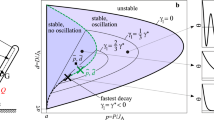Abstract
During an upright stance of humans, it is usually assumed that a stiffer ankle joint contributes to stabilize the stance. To show that under certain conditions a stiffer ankle joint can reduce the stability, the frequency responses of the moment and the angle of the ankle joint against external disturbances caused by random horizontal translations of the support surface were evaluated in ten healthy adult subjects by varying the difficulty of the task at four levels. When it was difficult to keep the upright stance, the subject tended to make the ankle joint stiffer. The transfer function relating the external disturbance moment to the ankle joint moment showed a larger gain in the high frequency range (>0.3 Hz) compared with the gains obtained under easier conditions. A simulation analysis based on a simple inverted pendulum model also reproduced this tendency. These results indicate that the stiffer ankle joint and the resulting higher ankle moment for high frequency external disturbances enhance the possibility that the center of pressure exceeds the limit arising from the size of the feet and can make the upright stance unstable.






Similar content being viewed by others
References
Agarwal GC, Gottlieb CL (1977) Compliance of the human ankle joint. Trans ASME 99:166–170
Benjuya N, Melzer I, Kaplanski J (2004) Aging-induced shifts from a reliance on sensory input to muscle cocontraction during balanced standing. J Gerontol Part A Biol Sci Med Sci 59:166–171
Fitzpatrick RC, Taylor JL, McCloskey DI (1992) Ankle stiffness of standing humans in response to imperceptible perturbation: reflex and task-dependent components. J Physiol (Lond) 454:533–547
Fujisawa N, Masuda T, Inaoka H, Fukuoka Y, Ishida A, Minamitani H (2005) Human standing posture control system depending on adopted strategies. Med Biol Eng Comput 43:107–114
Ho CY, Bendrups AP (2002) Ankle reflex stiffness during unperceived perturbation of standing in elderly subjects. J Gerontol Part A Biol Sci Med Sci 57:344–350
Horak FB, Nashner LM (1986) Central programming of postural movements: adaptation to altered support-surface configurations. J Neurophysiol 55:1369–1381
Ishida A, Hozumi J, Imai S, Ryumae S, Shimizu M (1995) Measurement of visco-elastic properties of muscles around the ankle during standing. Front Med Biol Eng 7:35–43
Ishida A, Imai S (1980) Responses of the posture-control system to pseudorandom acceleration disturbances. Med Biol Eng Comput 18:433–438
Johansson R, Magnusson M, Akesson M (1988) Identification of human postural dymamics. IEEE Trans Biomed Eng 35:858–869
Kiemel T, Oie KS, Jeka JJ (2006) Slow dynamic postural sway are in the feedback loop. J Neurophysiol 95:1410–1418
Loram ID, Lakie M (2002) Direct measurement of human ankle stiffness during quiet standing: the intrinsic mechanical stiffness is insufficient for stability. J Physiol (Lond) 545(3):1041–1053
Loram ID, Maganaris CN, Lakie M (2004) Paradoxical muscle movement in human standing. J Physiol (Lond) 556(3):683–689
Maurer C, Mergner T, Peterka RJ (2006) Multisensory control of human upright stance. Exp Brain Res 171:231–250
Nashner LM (1976) Adapting reflexes controlling the human posture. Exp Brain Res 26:59–72
Nashner LM, McCollum G (1985) The organization of human postural movements: a formal basis and experimental synthesis. Behav Brain Sci 8:135–172
Peterka RJ (2002) Sensorimotor integration in human postural control. J Neurophysiol 88:1097–1118
Winter DA (1990) Biomechanics and motor control of human movement. Wiley, New York
Winter DA, Patla AE, Ishac M, Gage WH (2003) Motor mechanism of balance during quiet standing. J Electromyogr Kinesiol 13:49–56
Zatsiorsky VM, Duarte M (2000) Rambling and trembling in quiet standing. Motor Control 4:185–200
Author information
Authors and Affiliations
Corresponding author
Rights and permissions
About this article
Cite this article
Ishida, A., Masuda, T., Inaoka, H. et al. Stability of the human upright stance depending on the frequency of external disturbances. Med Biol Eng Comput 46, 213–221 (2008). https://doi.org/10.1007/s11517-007-0269-8
Received:
Accepted:
Published:
Issue Date:
DOI: https://doi.org/10.1007/s11517-007-0269-8




